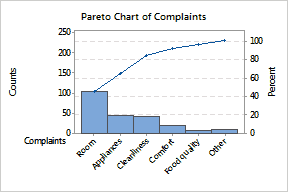
Typically the left y-axis is frequency of occurrence, and the right y-axis is the cumulative percentage of the total number of occurrences.
The x-axis displays the categories of defects, complaints, waste, etc.
A special type of bar chart where the plotted values are arranged from largest to smallest. A Pareto chart is one of the basic quality control tools used to highlight the most frequently occurring defects, the most common causes of defects, or the most frequent causes of customer complaints.
The Pareto chart is named for Vilfredo Pareto and his principle of the "80/20 rule." That is, 20% of the people contain 80% of the wealth; or 20% of the product line may generate 80% of the waste; or 20% of the customers may generate 80% of the complaints, etc.
For example, you want to investigate causes of customer dissatisfaction at your hotel chain so you investigate and record customer reasons for their complaints.
|
|
Typically the left y-axis is frequency of occurrence, and the right y-axis is the cumulative percentage of the total number of occurrences. The x-axis displays the categories of defects, complaints, waste, etc. |
A weighted Pareto chart not only considers the frequency of occurrence, but the importance as well. A weighted Pareto chart can account for the severity of the defects, or the cost, or anything else you would like to track. For example, suppose you have 5 coating defects that you are tracking: wrinkles, stains, scratches, dirt specs, and bubbles.
You collect data on the frequency of defect occurrence and the cost to rework. A weighted Pareto chart may change your priority for improvement projects by considering data based on both cost and frequency data. For example, even though wrinkles may be more frequent they are less expensive to fix than dirt specs, which are a rarer occurrence. Considering both cost and frequency will give you a better understanding of your cost of poor quality (COPQ).
|
|
|
|
The most frequently occurring defects are wrinkles and stains. Based just on this information, you may decide to develop an improvement project around reducing wrinkles and stains. |
The most costly defects are scratches and dirt specs. Based on this more informative data, you decide it is better to develop an improvement project to reduce scratches and dirt specs. |